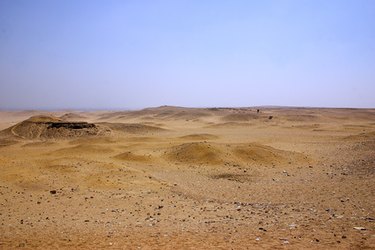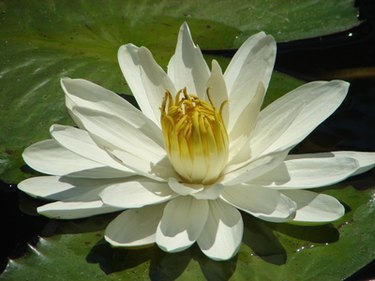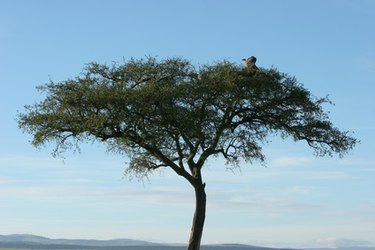
Egypt's desert is the Sahara, which stretches across much of northern Africa. The few plants that have adapted to the Sahara rely on water retention and protection from animals in the form of spines or toxins. The plants that thrive are in and around the Nile River, which cuts through Egypt and provides fertile soil in the desert. Although the Sahara encompasses multiple countries, certain plants are found only around Egypt and have had important uses or symbolic meanings.
Papyrus Plant
Video of the Day

Cyperus papyrus, commonly known as the papyrus plant, was once common in Egypt, having been heavily cultivated by the ancient Egyptians. But the plant has become rare in its native habitat, the Nile Delta, because of competition from invasive species and the reduction in cultivation.
Video of the Day
Papyrus is an herbaceous perennial, sprouting and growing through the spring and summer, dying in autumn and winter, then resprouting from its root stock. A fully mature plant has a thin, triangular stem topped by several thin green-brown grasslike growths.
Historically, papyrus was dried and weaved into paper, and its natural buoyancy made it a good material for boat making.
Water Lilies

Nymphaea, the water lily, is a flowering plant that grows primarily in the Nile Delta but lives in oases in the Egyptian desert. These lilies are also known as lotuses, although they are not related to the true lotuses found in India and China.
The plant grows in deep water, where its roots remain untethered to the soil. It has a large leaflike pad that remains afloat on the water. A long, thin stem topped with the flowering bulb protrudes from the pad.
Egypt has two species of water lilies, with opposing characteristics. The white water lily, Nymphaea lotus, blooms at night and closes in the morning. The blue water lily, Nymphaea caerulea, blooms in the morning and sinks into the water at night. These lilies played a large role in ancient Egyptian symbolism, representing death and rebirth.
Acacia Trees

Very few trees are adapted to survive in the Egyptian desert. The acacia grows primarily in desert wadis, which are dry riverbeds except when rainwater collects in and around the Nile. The plant consists of a narrow, thin trunk, small leaves and numerous spines. The acacias may grow far apart from one another, and it is not uncommon to find a lone acacia tree amid a vast area of desert. This occurs because of the low chance of pollination among the species, and the inability of the environment to support a large population in a single area.
Acacia trees had many uses in Egyptian culture. Their resin was used as ointment for wounds, and the leaves were used to color paint. The trees yielded durable and water-resistant timber, but their thin stature meant each tree could provide very little useful material.